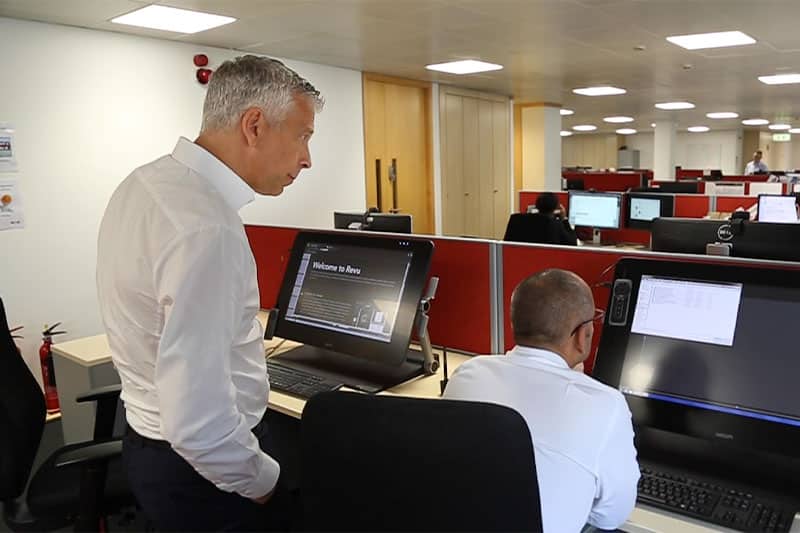Hilson Moran is one of the most prestigious environmental engineering and design consultancies in the world. But, like much of the design and construction industry, the firm is still in its relative infancy when it comes to digitizing its document design, storage and review infrastructure.
Vince Ugarow, a director at the firm, talked with the Bluebeam Blog about its continued progress with digitization using Bluebeam Revu. Edited excerpts:
Bluebeam Blog: Why did Hilson Moran choose Bluebeam Revu?
Ugarow: We didn’t actually choose it. We almost came across it by accident. We were looking at some hardware apparatus, and the piece of hardware we were looking at had Bluebeam Revu on it. We started playing around with it, and suddenly realized this is not just a PDF viewer; there’s something more to this.
Bluebeam Blog: What problems were you looking to solve with Revu?
Ugarow: One of the things we were looking at doing is to try and standardize a lot of the actual production of drawings. When you look back at the paper-based days, the simple things like commenting or reviewing drawings—this was done by many different engineers by hand. They all used different pen colors and handwriting.
Some of it was awful; you couldn’t read it. You can imagine when that was issued as a package to a client, it didn’t look the best. Our expectations with using Bluebeam Revu was that if we could actually use the markup tools, which standardize everything, it starts to look like a proper professional document.
Bluebeam Blog: How has your digital journey impacted the business thus far?
Ugarow: First of all, in terms of the actual users within the company, there’s now a digital record of everything that we produce. Previously, it was all paper-based; it was all put in storage. There’s no way in the world that you can access that.

The other big impact is that we have offices not just in the U.K. but overseas. On large international projects, it’s not unusual to have three or four different offices working on the same project. The digital transformation means that everyone’s got that information at their fingertips, whereas previously it was very difficult. You’re duplicating a lot of information and printing stuff out to send across other offices, so it wasn’t very productive.
Bluebeam Blog: How has the digital journey fostered internal collaboration at Hilson Moran?
Ugarow: When we’re coordinating designs, you only do it once as opposed to two, three, four iterations. There is obviously still coordination issues you have to address, but the main benefit is that everyone starts to work as a team.
With the advent of computers, if you actually look at the way most offices operate, everyone’s sort of chained to their desk. What we’re trying to do is to encourage collaboration that’s both a collaboration in-person by having interactive sessions but also collaboration using digital tools. It’s been a real benefit to our staff and all our engineers.
Bluebeam Blog: How has your digital journey been received by your clients?
Ugarow: Probably the biggest one is when we actually design our installations, they are far more accurate. They’re far more coordinated and the package that’s delivered—particularly to contractors, who then price our designs—gives them the confidence that this has been properly coordinated. Therefore, they don’t have to price in any risk, which for clients is a great benefit because it eliminates wastage, higher costs and potential program delays.
Bluebeam Blog: What advice would you give a firm looking to similarly transition to digital?
Ugarow: Obviously, you need to have support and the conviction from the very top. That’s very important. But also, what’s really important is to have the grassroots of the company actually come up with the ideas.
In other words, we were quite keen to get engineers who are working on projects to come up with the ideas and then almost form test slabs to pilot these ideas—and then bring in other users to see if that works. And once we’re happy we could then roll that out across the company. That grassroots level—that’s where it really was a success, rather than someone higher up saying, “This is the way you guys are going to do it.” That will never work.
Bluebeam Blog: What’s the one thing you would want people to know about Hilson Moran’s digital journey?
Ugarow: That it hasn’t stopped—and it will never stop. It’s going to be continuous. With the evolution of digital technology, it’s not a question of coming up with a solution, issuing it and saying, “Right, that’s it. That’s done.” It’s ever-evolving, and that’s something that I think everyone needs to understand. Things are going to change continually, more so now than they probably did in the last 20, 30, 40 years in our industry. I think it’s a matter of just saying, “We’ve taken the first steps. We’ve been successful. We’re now pushing into the more advanced areas, but this is just going to continue.”










